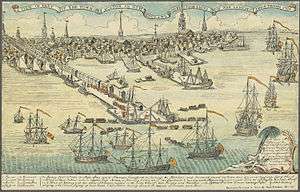Journal of Occurrences
The Journal of Occurrences, also known as Journal of the Times and Journal of Transactions in Boston, was a series of newspaper articles published from 1768 to 1769 in the New York Journal and Packet and other newspapers, chronicling the occupation of Boston by the British Army. Authorship of the articles was anonymous, but is usually attributed to Samuel Adams, then the clerk of the Massachusetts House of Representatives. William Cooper, Boston's town clerk, has also been named as a possible author. The articles may have been written by a group of people working in collaboration.
History

The occupation of Boston arose from colonial resistance to the Townshend Acts, passed by the British Parliament in 1767. In response to the acts, the Massachusetts House of Representatives issued the Massachusetts Circular Letter in February 1768. Also written primarily by Samuel Adams, the circular letter argued that the Townshend Acts were a violation of the British Constitution because they taxed British subjects without their having a say in the matter.[1] Lord Hillsborough, British Secretary of State for the colonies, ordered the Massachusetts House to revoke the circular letter. But the legislature refused. In addition to this act of colonial defiance, Hillsborough also heard reports from the Board of Customs—who were in charge of enforcing trade regulations—that Boston was in a state of anarchy. The British ministry dispatched four regiments of the British Army to restore order. These troops began arriving on October 1, 1768.[2]
The first installment of the Journal, covering the period of September 28 to October 3, 1768, was published on October 13, 1768, and was titled Journal of Transactions in Boston. Subsequent issues appeared once a week, with an average lapse of about twelve days between the reported events and the date of publication. Copy was secretly sent from Boston to New York for publication in the New York Journal on Thursday, then reprinted on Saturday in the Pennsylvania Chronicle; it was then printed in the Boston Evening Transcript, and copied in many other American newspapers and publications. The title changed several times, with the New York papers most often using Journal of Occurrences and the Boston papers preferring Journal of the Times.[3]
In an innovative approach for an era without professional newspaper reporters, the Journal presented a narrative of shocking events in Boston to the outside world.[4] The authors claimed that what they wrote was "strictly fact", while British officials in Boston insisted that it was mostly fiction.[3] Drawing upon the traditional Anglo-American distrust of standing armies garrisoned among civilians, the Journal presented a Boston besieged by unruly British soldiers, who assaulted men and raped women with regularity and impunity.[5] The customs commissioners were also portrayed negatively.[6]
Historian Richard Frothingham, Jr. claimed that William Cooper, the town clerk, did most of the writing; Governor Francis Bernard attributed it to Samuel Adams and his associates. Other possible authors include Henry Knox, who was running a bookstore at the time; Benjamin Edes, co-publisher of the Boston Gazette; William Greenleaf, an employee of Edes; and Isaiah Thomas, who started out as a printer's apprentice and went on to publish the Massachusetts Spy. Historian Oliver M. Dickerson suggests that John Adams or Josiah Quincy helped with the legal material, such as the discussion of the writs of assistance in April 1769.[3]
Governor Bernard complained in a letter to Lord Hillsborough that "if the Devil himself was of the party, as he virtually is, there could not have been got together a greater collection of impudent, virulent, and seditious lies, perversions of the truth, and misrepresentations, than are to be found in this publication." Dickerson writes in his introduction to the collected articles that it "doubtless" contains exaggerations, but that most of the allegations are supported by letters and other contemporary documents.[3] In any case, the articles helped build the sentiment that eventually produced the American Revolution.
References
Citations
- Alexander 2004, p. 52.
- Alexander 2004, p. 65.
- Dickerson 1936, pp. viii-ix.
- Alexander 2004, pp. 68-69.
- Archer 2010, p. 13.
- Dickerson 1936, p. xi.
Bibliography
- Alexander, John K. (2004). Samuel Adams: America's Revolutionary Politician. Lanham, Maryland: Rowman & Littlefield. ISBN 9781461642787.CS1 maint: ref=harv (link)
- Archer, Richard (2010). As If an Enemy's Country: The British Occupation of Boston and the Origins of Revolution. Oxford University Press. ISBN 9780199745951.
- Dickerson, Oliver M. (1936). Boston under Military Rule (1768–1769): As Revealed in a Journal of the Times. Boston: Chapman & Grimes.CS1 maint: ref=harv (link)

Further reading
- Fowler, William M. Jr. (1997). Samuel Adams: Radical Puritan. New York: Longman. ISBN 9780673992932.CS1 maint: ref=harv (link)
- Streitmatter, Rodger (2007). Mightier Than the Sword: How the News Media Have Shaped American History. Westview Press. ISBN 9780813343907.CS1 maint: ref=harv (link)